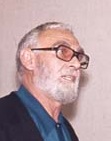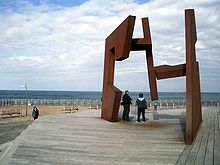You can help expand this article with text translated from the corresponding article in Basque. Click for important translation instructions.
|
| Jorge Oteiza | |
|---|---|
 | |
| Born | Jorge de Oteiza Embil (1908-10-21)October 21, 1908 Orio, Gipuzkoa, Spain |
| Died | (2003-04-09)April 9, 2003 (aged 94) San Sebastián, Gipuzkoa, Spain |
| Known for | Sculpture, architecture, and writing |
| Movement | Equipo 57, Gaur, Land art |
| Awards | Prince of Asturias Award for the Arts |
Jorge Oteiza Enbil (October 21, 1908 – April 9, 2003), was a Basque Spanish sculptor, painter, designer and writer from the Basque Country, renowned for being one of the main theorists on Basque modern art. Oteiza was born in Orio (Gipuzkoa, Basque Autonomous Community, Spain). He moved to South America in 1935, just before the Spanish Civil War, and stayed there for 14 years. In 1963 he published Quosque tandem!, an essay about the aesthetics inherent to Basque soul, based on prehistoric art found in Basque regions and Basque people's anthropological roots. Three years on, he contributed to found the artistic group Gaur.
He died in San Sebastián, Gipuzkoa, in 2003. Following his will, a month after his death a museum dedicated to his career was opened in Altzuza, Navarre, in the place where he had lived since 1975. The Oteiza Museum is a monographic exhibition space housing the personal collection of Jorge Oteiza, which includes 1,690 sculptures, 2,000 experimental pieces from the artist's Chalk Laboratory, and an extensive collection of drawings and collages.
Main prizes and awards




Jorge Oteiza was granted several prizes and awards throughout his life:
- 1953 — Only Spanish sculptor selected for the international competition for the Monument to the Unknown Political Prisoner. The project is exhibited in the Tate Gallery (London).
- 1954 — Spanish National Award of Architecture, for a project to do a chapel on the Road to Santiago. It was a joint project, together with architects F. J. Sáenz de Oiza and Luis Romaní, and it was not carried out.
- 1957 — Grand Prix for his sculpture at the IV São Paulo Art Biennial (Brazil).
- 1970 — First Prize in the competition for the urban planning of the Plaza de Colón in Madrid. It was a joint project, together with Angel Orbe, Mario Gaviria and Luis Arana, and it was not carried out.
- 1985 — Gold Medal for Fine Arts, awarded by the Spanish Ministry of Culture.
- 1986 — Selected for the exhibition Qu’est-ce que la sculpture moderne? 1900-1970, held in the Museum of Modern Art at the Georges Pompidou Center in Paris.
- 1988 — Prince of Asturias Prize for the Arts.
- 1991 — Gold Medal of Navarre, awarded by the Government of Navarre.
- 1995 — Manuel Lekuona prize by Eusko Ikaskuntza (Society of Basque Studies).
- 1996 — Pevsner Prize (Paris), in recognition of his life's work.
- 1996 — Honorary member of the Vascon-Navarrese Architect's Association.
- 1998 — Doctor honoris causa by the University of the Basque Country.
- 1998 — Madrid Fine Arts Circle Medal.
- 1998 — Gipuzkoa Gold medal.
References
- Grace Glueck (2005-07-08). "'Emptying' Sculpture to Make Room for Spiritual Energy". The New York Times. Retrieved 2010-03-02.
- ^ Zallo, Ramón (2007). Basques, today. Alberdania. p. 144. ISBN 978-84-96643-59-8.
- de Oteiza, Jorge; Zulaika, Joseba (2003). Oteiza's selected writings. University of Nevada Press. p. 12. ISBN 978-1-877802-43-0.
- Oteiza; Zulaika (2003), p. 286
- "Oteiza Museum: General Information," Archived 2011-07-27 at the Wayback Machine from the Oteiza Museum's website. Retrieved 2010-11-08.
- "Biography," from the Oteiza Museum's website. Retrieved 2010-11-08.
External links
- Oteiza Museum in Alzuza, Navarre
- Biography
- Oteiza's Selected Writings at the Basque Database Archived 2016-01-01 at the Wayback Machine
- Two Basque Sculptors. Peter Selz on Oteiza and Chillida
- Arana Cobos, Juan (2008). Jorge Oteiza: Art as Sacrament, Avant-Garde and Magic. PhD dissertation, Center for Basque Studies. University of Nevada, Reno.